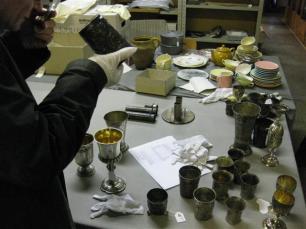Provenance research
The legacy of Nazism still poses legal problems to museums to this day. Through the so-called “Aryanisation” of Jewish possessions in the “Third Reich”, cultural assets – sometimes of considerable value – ended up in exhibitions and repositories through forced under-value sales or expropriations. Due to the inventory of the objects often being consciously left incomplete, it is difficult to determine the rightful owners.
The Historical Museum began to come to terms with its own history of the illegal appropriation of Jewish property in the early 2000s. Initially, the focus was on the painting collection, since the history of acquisition can be better traced through the identification of artists and subjects than is possible with other museum pieces. With the limited financial resources available, initial results could be presented, but the collection could not be examined in its entirety.
Funded by the Arbeitsstelle für Provenienzforschung in Berlin (now the Stiftung Deutsches Zentrum für Kulturgutverluste in Magdeburg), a provenance research project existed at the Historisches Museum Frankfurt between 2010 and 2015. During this time, the art historian Maike Brüggen examined the paintings and various objects from other collections of the museum from the years 1933 - 1945 with regard to their past. The focus was on questions about the previous owners and the reasons for their sales, donations or endowments to the museum. This is done by determining and deciphering inscriptions on the backs, artis and owner notes in the case of paintings or handwritten entries, dedications, initials or stamps in the case of books, as well as by researching previous owners in catalogs, file inventories and sales documents or letters.
In the case of an unlawful seizure or involuntary sale due to Nazi persecution, the Museum strives to reach a fair and just solution with the rightful owners on the basis of the so-called Washington Principles and the Joint Declaration.An example of a successful restitution of a painting to the heirs of the original owners is the painting by Hans Thoma: “Sommer (Frau mit Kind)” (Summer, Woman with Child).
All previously unknown accessions to the house from the period between 1933 and 1945 have been published in the LostArt internet database of the Deutsches Zentrum für Kulturgutverluste. Some of the research results have found their way into the first presentation of the new permanent exhibition of the Historisches Museum Frankfurt in 2012. The focus here is on the art collection of the Jewish collector Julius Heyman (1863 - 1925). The art-historically important Heyman collection of small art, arts and crafts as well as paintings from the Middle Ages, Renaissance and Baroque was initially presented in Heyman's residence at Palmstraße 16 in Frankfurt in staged period rooms. Heyman bequeathed the house and its contents to the city of Frankfurt and stipulated that the house and its inventory should be made accessible to the public and become part of the Frankfurt Historical Museum as a separate department.
The collection was broken up against the donor’s wishes in 1940. Some of the art objects were given to different museums in the city; others were sold. The aim of the project – which continues to work on completing the data – was to trace the collection pieces so that the collection could be united once again, at least in virtual form.
The coat of arms of Saint Jerome is a prominent object from the old collection of Julius Heyman which has already been worked on.
In several years of meticulous research work, the long-time curator Jürgen Steen devoted himself to the project of "looted silver", which focused on silver objects of the house with unclear provenance. Some of the objects suspected of having been spoliated were presented with the complex acquisition history in the museum's permanent exhibition starting in 2007. Jürgen Steen remains connected to provenance research even after his retirement and continues to do research for the Historical Museum on a voluntary basis. It is thanks to his commitment that nine objects were identified that originated from the Museum of Jewish Antiquities. The museum was vandalized on Progrom Night in 1938, its collections partially destroyed and objects transferred to the History Museum. In August 2018, the identified objects could be handed over to the Jewish Museum Frankfurt as the ideal successor institution of the Museum of Jewish Antiquities (from there, most of these objects were restituted to the Jewish Community Frankfurt, but given to the Jewish Museum as a permanent loan).
In cooperation with the Museum Angewandte Kunst, the Weltkulturen Museum, and the Jewish Museum, a joint exhibition project was developed in 2016, which was integrated into the exhibition at the Historisches Museum entitled "Bought. Collected. Looted? The Way of Things into the Museum". The exhibition, which was presented from May to October 2018 on the upper floor of the new building, dealt with the traces of the "legalized robbery", as a result of which Jewish citizens were expropriated. Their possessions could be acquired under "favorable" conditions by private individuals and public institutions. The Historical Museum also took advantage of this to supplement and expand its collections. As part of the exhibition, objects from the collection were asked about their origin and ownership history. This was supplemented by an urban laboratory project that addressed presumed looted property in private ownership under the titel "Difficult Things".

